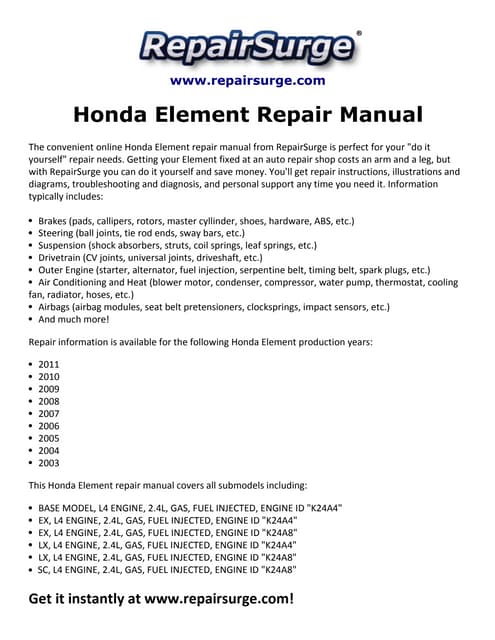Troubleshooting a 2003 Honda Element involves identifying common issues like transmission problems or engine misfires. Key steps include checking the vehicle’s diagnostic codes and inspecting for any visible wear and tear.
The 2003 Honda Element, known for its unique design and versatile interior, has been a favorite among outdoor enthusiasts and city dwellers alike. Yet, like any vehicle, it’s not immune to problems. Owners often face challenges ranging from electrical glitches to suspension issues.
Understanding these common troubles can save time and money. This guide aims to provide owners with straightforward solutions and maintenance tips to ensure their Element remains reliable. By focusing on proactive care and prompt troubleshooting, you can extend the life of your 2003 Honda Element, keeping it ready for your next adventure or daily commute.
Introduction To Honda Element Issues
The Honda Element, recognized for its boxy shape and utilitarian features, emerged as a versatile vehicle in 2003. Its distinct design and functionality made it a favorite among outdoor enthusiasts and pet owners alike. Yet, like all vehicles, the Element has its set of challenges that owners might face over time.
Popularity And Reliability
The Element gained popularity due to its spacious interior and flexible seating. Its reliability scores well in consumer reports. However, age and mileage can lead to typical wear and tear, necessitating troubleshooting for various issues.
Common Concerns
- Transmission glitches – Shifting delays or jerks may occur.
- Engine problems – Stalling or loss of power can happen.
- Suspension noise – Clunks or squeaks are common.
Engine Performance Problems
The 2003 Honda Element is known for its utility and reliability. Yet, engine performance issues can arise. Owners may notice starting troubles or rough idling. Let’s troubleshoot these common problems.
Starting Difficulties
Starting issues in your Honda Element can stem from multiple sources. A weak battery, faulty starter, or ignition problems are often to blame. Check these components:
- Battery: Test for adequate charge and clean terminals.
- Starter: Listen for clicking sounds indicating starter issues.
- Ignition system: Ensure spark plugs and wires function properly.
A professional mechanic can diagnose and fix these starting difficulties.
Rough Idling Fixes
Rough idling can make your drive uncomfortable. It can also hint at underlying engine troubles. Address rough idling with these steps:
| Issue | Fix |
|---|---|
| Dirty air filter | Replace the filter to improve airflow. |
| Spark plug degradation | Install new spark plugs for better ignition. |
| Fuel system cleaning | Clean injectors to enhance fuel delivery. |
Regular maintenance prevents rough idling and keeps your Element smooth.
Transmission Glitches
The 2003 Honda Element is known for its utility and reliability. Yet, some owners face transmission issues. These glitches can affect the driving experience. Let’s troubleshoot and find solutions for common transmission problems.
Recognizing Shift Delays
Shift delays are a sign of transmission trouble. You might notice your Element hesitates before moving. This delay can occur when shifting between gears. It’s critical to recognize these symptoms early to prevent further damage.
- Engine revs without car movement
- Delayed gear engagement
- Sudden gear shifts while driving
Tips For Smoother Gear Transitions
To ensure smooth gear transitions, regular maintenance is key. Follow these tips to keep your Element’s transmission in top shape.
- Use the correct transmission fluid.
- Change the fluid at recommended intervals.
- Check for transmission leaks often.
- Get a professional diagnosis if issues arise.

Credit: www.slideshare.net
Electrical System Anomalies
The 2003 Honda Element is known for its practicality and versatility. Yet, like any vehicle, it may face electrical issues. Owners often report quirks in the vehicle’s electrical system. Understanding common problems helps in quick troubleshooting. Let’s explore some frequent electrical system anomalies.
Battery Draining Issues
Battery draining can leave drivers stranded. A few culprits include:
- Old batteries losing charge.
- Loose connections stopping power flow.
- Parasitic drains overnight.
Regular battery checks can prevent unexpected power loss. Look out for dimming dashboard lights or slow engine cranks.
Headlight And Taillight Malfunctions
Properly working lights are crucial for safe driving. Common light issues involve:
- Burnt-out bulbs needing replacement.
- Faulty wiring causing intermittent function.
- Blown fuses needing new ones.
Regular inspections ensure lights function correctly. Replace bulbs and fuses as needed for uninterrupted visibility.
Suspension System Wear And Tear
The suspension system in your 2003 Honda Element is key to a smooth ride. Over time, shocks and struts might degrade. This can affect comfort and control. Regular checks are essential. They ensure your vehicle remains safe and enjoyable to drive.
Detecting Unusual Noises
Unusual noises often signal suspension issues. Listen for creaks or knocks when turning. A clunking sound when going over bumps can mean trouble. These sounds suggest worn components. They need a professional look. Early detection saves you from bigger repairs later.
Common noise-related signs include:
- Squeaking when driving over uneven roads
- Clunking sounds in the wheel wells
- Knocking during sharp turns or stops
Maintaining A Smooth Ride
A smooth ride is a must for any driver. Keep your Element’s suspension in top shape. Regular maintenance is important. It includes inspections and part replacements when necessary. Addressing problems early keeps the ride smooth. It also extends the life of your vehicle.
Tips for suspension care:
- Check tires for even wear and proper inflation
- Inspect shocks and struts for signs of oil leaks
- Get a professional alignment check annually
Follow these steps to avoid bumpy rides. They ensure your Element stays reliable on the road.
Braking System Maintenance
Your 2003 Honda Element is a reliable ride. Proper care is key. Braking system maintenance keeps you safe. It’s essential for your car. Let’s dive into the details.
Brake Pad Lifespan
Brake pads are vital. They wear down over time. You must check them regularly. Aim for every 12,000 miles. Signs of wear include squeaking and longer stopping distances. Replace them as needed. It keeps your Element stopping smoothly.
Ensuring Effective Stopping
Effective brakes save lives. They need good care. Check your brake fluid often. It should be clean and at the right level. Inspect the brake lines too. Look for leaks or damage. Fix issues quickly. This ensures top-notch performance.
Remember these tips:
- Listen to your brakes.
- Feel the brake pedal.
- Look at the brake parts.
Keep your Element’s brakes in check. It makes your ride safe. Follow a maintenance schedule. Stick to it. Enjoy peace of mind on the road.
Interior Comfort Concerns
The 2003 Honda Element offers unique features. Yet, some owners face interior comfort concerns. We explore common issues. Plus, we provide troubleshooting tips. This guide ensures your ride remains cozy and enjoyable.
Climate Control Troubleshooting
The climate system in your Honda Element keeps the cabin comfortable. Sometimes, it might not work right. Here are steps to fix common issues:
- Check the fuse: A blown fuse can stop the system. Replace if needed.
- Inspect the thermostat: It controls temperature. Ensure it’s working.
- Clean the air filters: Dirty filters block airflow. Clean or replace them.
These steps often solve climate control problems. They keep air fresh and temperature right.
Seat Adjustment Mechanism
Comfortable seating is key in the Element. Yet, the seat adjustment might stick or break. Here’s how to fix it:
- Inspect the lever: Make sure it moves freely. Apply lubricant if stiff.
- Check for obstructions: Objects can block the mechanism. Remove any found.
- Consult the manual: It has a troubleshooting section for seat issues.
These steps help maintain seat comfort. They ensure adjustments are smooth and easy.
Exterior Challenges
The 2003 Honda Element faces exterior challenges over time. Elements like rust and water leaks can damage the car. Proper maintenance ensures your Element stays in top shape. Let’s explore some common issues and solutions.
Rust Prevention Strategies
Keeping rust at bay is crucial for your Element. Here are strategies to prevent rust:
- Regular Washing: Clean your car often. Remove dirt and grime that can cause rust.
- Waxing: Apply wax twice a year. Wax protects the paint and body.
- Inspect Regularly: Check for rust spots often. Early detection is key.
- Anti-Rust Treatment: Consider professional anti-rust treatments. They shield against corrosion.
Window Sealing And Water Leaks
Seals around windows can fail. This can cause water leaks. Follow these steps to fix leaks:
- Inspect Seals: Look for cracks or gaps in the seals. These are leak signs.
- Clean Seals: Clean the seals with a mild detergent. This can extend their life.
- Sealant Application: Use a silicone-based sealant on any gaps. This stops leaks.
- Professional Help: If leaks persist, seek a mechanic. They can provide expert help.
Diy Tips For Regular Upkeep
Maintaining your 2003 Honda Element can be simple and cost-effective. Regular upkeep at home keeps your Element running smoothly. Follow these DIY tips to ensure your Honda stays in top condition.
Easy Cleaning Hacks
Keeping your Honda Element clean is vital for its longevity. Use these hacks for a spotless ride:
- Vacuum regularly to remove dirt and debris from carpets and seats.
- Wipe down interior surfaces with a microfiber cloth and mild cleaner.
- Clean windows inside and out for clear visibility.
- Remove seat covers and wash according to the manufacturer’s directions.
Preventative Measures
Take these steps to prevent issues before they arise:
- Check oil levels bi-weekly and top off as needed.
- Inspect tires monthly for proper inflation and tread wear.
- Test battery charge every six months to avoid surprises.
- Replace air filters annually for better engine performance.
Regular maintenance ensures your Honda Element stays reliable. Perform these tasks to keep your vehicle healthy.

Credit: m.youtube.com
Professional Help Vs. Self-servicing
Deciding between professional help and self-servicing your 2003 Honda Element is critical. Your choice impacts cost, time, and vehicle health. Let’s explore when to seek experts and useful resources for Honda Element owners.
When To Call The Experts
- Complex Electrical Issues: Wiring problems need expert diagnosis.
- Transmission Troubles: Specialists handle gearbox repairs best.
- Engine Overhauls: Mechanics have the tools for major engine work.
- Safety Systems: Professionals ensure your safety features function properly.
Resources For Honda Element Owners
Owners have access to various resources for maintaining their Honda Element.
| Resource | Description |
|---|---|
| Manuals | Find repair instructions in your Element’s manual. |
| Forums | Join discussions with other Element owners online. |
| Parts Suppliers | Get quality parts from recommended suppliers. |
| DIY Videos | Watch tutorials for simple fixes and maintenance. |

Credit: www.caranddriver.com
Frequently Asked Questions
What Are The Problems With A 2003 Honda Element?
Common problems with the 2003 Honda Element include transmission issues, suspension problems, and high oil consumption. Owners also report air conditioning failures and power lock malfunctions. These issues can impact driving experience and maintenance costs.
Why Is My Honda Element Not Starting?
Your Honda Element might not start due to a dead battery, faulty starter, bad fuel pump, or ignition issues. Check these components for any problems.
What Causes A Honda Element To Go Into Limp Mode?
A Honda Element may enter limp mode due to overheating, sensor malfunctions, transmission issues, or electrical problems. Regular maintenance can help prevent this safety feature from activating.
Do Honda Elements Have Problems?
Yes, Honda Elements can experience issues such as transmission problems, suspension noise, and seat belt wear. Regular maintenance helps prevent these common concerns.
What Causes Honda Element Starting Problems?
Common causes include a faulty starter, dead battery, or ignition switch issues. Regular maintenance helps prevent these problems.
Conclusion
Tackling issues with your 2003 Honda Element need not be daunting. Armed with this guide, you’re now equipped to address common problems. Regular maintenance and timely repairs can keep your Element running smoothly. Remember, a well-cared-for vehicle ensures reliability on the road.
Drive safe and enjoy your Honda Element’s enduring performance.
















